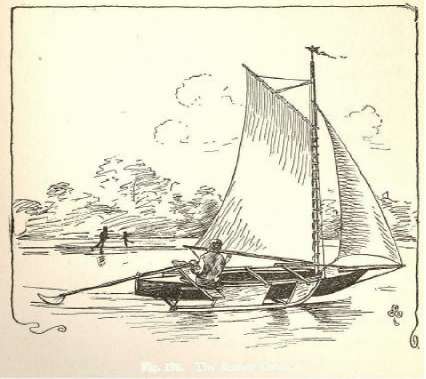The Scooter Canoe
Description
This section is from the book "The Scientific American Boy", by A. Russell Bond. Also available from Amazon: The Scientific American Boy.
The Scooter Canoe
Naturally we were very much elated at our success, and straightway made for the barn, where we began operations on the scooter canoe. The sleigh was an old-fashioned affair, with rather broad wooden runners. First we removed the body of the sleigh, and then the runners were cut down to a height of about 15 inches. We spaced them apart about 28 inches, and connected them with four crosspieces at the top.

Fig. 195. Runners of Scooter Canoe.

Fig. 196. The Scooter Canoe.
The runners were now placed over our larger canoe, with forward ends about on a line with the mast, and the crosspieces were fastened with screws to the gunwales. As an additional security, a pair of crosspieces were now run under the canoe at each end and fastened with screws to the keel. At the bow the keel was shod with a strip of brass. The rudder was taken off the boat, and an oar lock was fastened to the stern to hold the steering oar. In place of lee boards we nailed a couple of thin boards over each runner, as shown in the drawing. We were in a hurry to finish this, as our vacation was short, so we used on the scooter canoe the sails that we had made for our ice boat. This required a bowsprit, but as we had little time to spare we used the jib-boom of the ice boat, nailing it to the deck beam of the canoe. We decided that the jib-sail could be used without a boom, as we had done with the scow. The mast was braced by stays attached to the ends of the runners and bowsprit. This spread of canvas was far greater than that originally provided for sailing the canoe, but the heavy runners on each side helped to keep the boat on even keel, and then to further balance the sail a board was nailed across the aft end of the boat. This overhung the runners about 18 inches each side, and in a strong wind we could sit out on the windward end of this board, thus preventing the scooter from heeling over too far.
Continue to:


